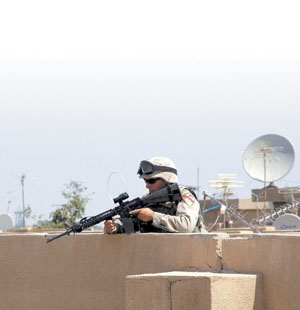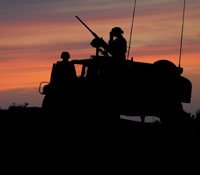Army Intelligence Incorporates Iraq Lessons
 |
| A soldier in the U.S. Army’s 1st Cavalry Division stands security from a rooftop in Iraq during an operation designed to gather intelligence. The Army is accelerating the implementation of intelligence techniques and technologies based on input from Afghanistan and Iraq. |
The Iraq War has provided a wealth of lessons that already are being applied to diverse U.S. Army intelligence disciplines such as sensors, situational awareness, information dissemination and secure conferencing. The Army has been incorporating many of these lessons by accelerating some programs and altering others, and many of these activities are supporting the ongoing Army transformation while others are altering its course.
As a result, some aspects of the force transformation are occurring faster than originally anticipated. The long-sought goal of the individual warfighter as an intelligence sensor is becoming a reality as vital information is digitized for transmission from the soldier’s handheld unit.
Most of the intelligence lessons learned in the Iraq War are related to opportunities and new capabilities rather than to shortcomings, observes Lynn Schnurr, Army G-2, director of intelligence community information management. A hallmark of the effort is the widespread adapting that has taken place during and after the conflict. Schnurr notes that the Army intelligence architecture must be dynamic, and it has been reviewed continuously and adapted over the past year. These advances have been implemented rapidly to forces in Afghanistan and Iraq.
“The most important point is that we’re fixing these things now,” Schnurr states. “We want that actionable intelligence, and the way to get it is through making sure that we provide the enhancements and improvements quickly to the force.”
A key part of this thrust is that the Army is digitizing intelligence information at a lower level to move it up through the echelons more quickly, Schnurr reports. To achieve its many related goals, the Army is using commercial off-the-shelf software wherever possible. The service also is spiraling technology to move it to the soldier now. She describes this effort as an enhancement of the intelligence, surveillance and reconnaissance (ISR) architecture developed after several visits to Iraq last year. An August 2003 visit, led by Army intelligence head Lt. Gen. Keith B. Alexander, USA, involved an on-the-ground ISR assessment that focused on identifying needed improvements.
The group returned from Iraq with 85 initial tasks that grew to 127 over the year. Schnurr credits the proactive approach to upgrading intelligence capabilities as the reason for that growth in tasks. Back in the United States, Army intelligence officials conducted secure videoconferences with officials in Iraq and Afghanistan to carry out those 127 tasks. As a result, only about three tasks remain to be completed from that original list, Schnurr declares. These involve items such as enhancing the communications architecture, implementing biometrics and digitizing data for dissemination to commanders.
The original task list was categorized into four separate areas: tactical reporting, collection, access to national data, and analytic centers.
In tactical reporting, the main need was to digitize the reporting quickly and make it available to the commanders for it to be actionable intelligence. One of the key elements in that area is Blue Force Tracking and Force XXI Battle Command, Brigade and Below, or FBCB2. This handheld device, which originated in the commander’s digital assistant project, is in high demand among warfighters. Schnurr relates that the Army has added some capabilities by spiraling technologies into the system. Enhancements include L-band satellite communications, which will provide an immediate-reporting capability, and a pick-list. The pick-list capability will allow a soldier on the ground to report intelligence quickly in a digitized format that can be sent up the chain. A tactical human intelligence (HUMINT) team or a combat patrol would use a drop-down box in the display to select entries on a pick-list to report observations.
This plays into the concept of every soldier as a sensor, Schnurr points out. An initial test conducted in early summer has led to improvements that should be fielded this month. The goal is to field 1,000 of the upgraded FBCB2 devices in Iraq and Afghanistan with tactical HUMINT teams and combat patrols, she says.
Secure videoconferencing is another area benefiting from technological upgrades. This capability now is available at the division level and has helped increase collaboration in theater and with Army intelligence back in the United States.
To obtain better analytic support, the Army established analytical centers in Baghdad and in Bagram, Afghanistan. Schnurr characterizes these centers, which are known as Information Dominance Centers–Extended (IDC-E), as extensions of the Information Dominance Center located in the U.S. Army Intelligence and Security Command (INSCOM) headquarters. New analytical tool advanced technology capabilities that provide data mining, better data access, visualization tools and link analysis come from this INSCOM center. The IDC-Es have advanced technology tools such as Pathfinder and Starlight that are used at the main center in INSCOM. The goal of the IDC-E concept is to provide intelligence analysts with better capabilities for dealing with the billions of bits of data that cross their workstations daily, Schnurr explains.
“We want the analyst to have more time to be analyzing instead of figuring out how to get the information,” she declares.
Another key point is to avoid unnecessary data filtering. To ensure that every bit of data is analyzed, the Army is turning to advanced technology tools that can mine the data, understand it and provide link analysis and visualization capabilities. The IDC-Es provide these tools, Schnurr notes. About one year ago, the Army provided these centers with a link analysis tool known as Analyst’s Notebook. It was purchased off the shelf and delivered to the IDC-Es in less than a week, Schnurr relates. This tool helps an analyst visually depict associations of people and events, even through aspects such as financial information. “An analyst simply cannot do that manually,” she warrants.
 |
| Soldiers from the Army’s 1st Infantry Division patrol an area in Iraq prior to an air strike. The change in enemy tactics following the collapse of Saddam Hussein’s regime has forced the Army to adapt to new procedures for combating hostile forces. |
As coalition forces captured large volumes of documents in both Afghanistan and Iraq, analysts have been forced to work overtime to sift through the data. An INSCOM subordinate command developed a national-level system known as Harmony that stores these captured documents. A deployable version has been moved to theater to scan and store the documents quickly for rapid identification and classification. This information is accessible on the Web via the secret Internet protocol router network (SIPRNET) and the Joint Worldwide Intelligence Communications System (JWICS) to all echelons, where officers can request a full translation of a document that has been given a priority listing.
Another important development was the fielding of the All-Source Analysis System–Light, or ASAS-Light, to the battalion level. This helps analysts deal with individual events and organizational data, Schnurr offers.
Persistent surveillance, which is a key element in U.S. Defense Department plans, has begun to see action with Army intelligence. Schnurr relates that Army intelligence has provided many new sensors over the past year. Many of these new sensors offer seismic or acoustic capabilities.
Improvements have come in both quality and quantity, Schnurr notes, as the Army has added and enhanced sensors. Most of the sensor advances have involved improvements, particularly in the realm of adding new technologies to existing sensors. Aerostats are blossoming over Iraq, and they will feature considerably better sensor capabilities. One such capability is known as the persistent threat detection system, she relates.
The Army also is exploring increased use of biometrics (SIGNAL, September, page 104) for secure identification. One system that Schnurr cites is used to enroll detainees and for local hire identification. She relates that late last July, the U.S. Navy picked up four individuals who were subjected to biometric identity screening. One person proved to be a former detainee who was tracked by the biometric system that targeted him for further investigation. Without the biometric match, this detainee could have claimed virtually any identity without fear of challenge or discovery.
Adding these new information technologies requires increased bandwidth, and the Army G-6 has been working to boost bandwidth capacities, Schnurr says. Next year should bring increased SIPRNET capabilities at lower echelons, and the fielding of the new Joint Network Node with some units also will improve bandwidth availability.
Industry will continue to play a role in helping Army intelligence realize the lessons learned in Afghanistan and Iraq. For hardware, personal digital assistants are high on the Army’s wish list. The Army is seeking additional form factors for some of its requirements, which include lighter weight, better survivability and lower power consumption. Similar criteria apply to laptop computers, which ideally would be tougher, better and lighter, Schnurr offers.
Power remains an issue, so industry should aim to provide better power supplies such as batteries that last longer. The Army also needs improved storage capabilities, she adds.
In software, Army intelligence needs analytical tools most of all, Schnurr says. Other key software requirements include advanced data mining abilities and visualization tools. Schnurr explains that analysts need to be able to visualize the large amount of information gathering on their screens to be able to process it effectively.
Industry must provide advanced technology concepts and deliver new technologies as quickly as possible, Schnurr maintains. Again, the focal point is to deliver new capabilities to the soldiers rapidly.
Web Resources
U.S. Army Intelligence and Security Command (INSCOM): www.inscom.army.mil
Army deputy chief of staff for intelligence (G-2): www.dami.army.pentagon.mil
FBCB2: http://peoc3t.monmouth.army.mil/FBCB/fbcb2.html


Comments